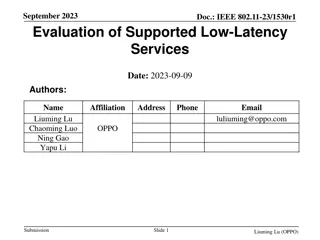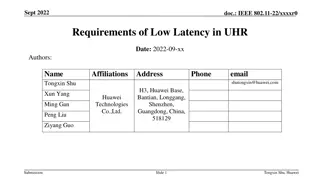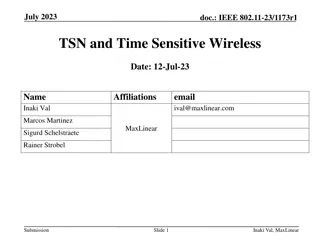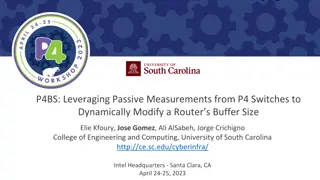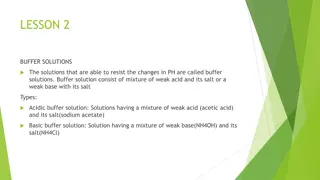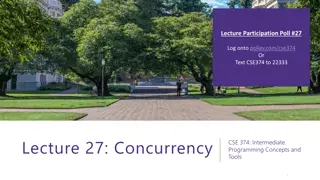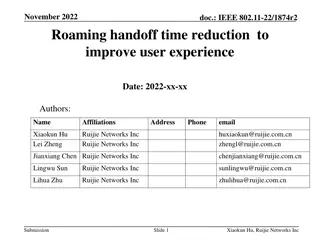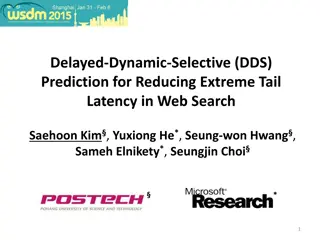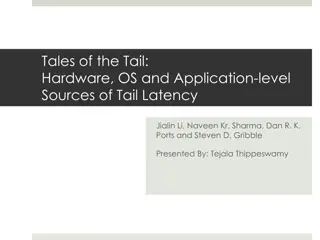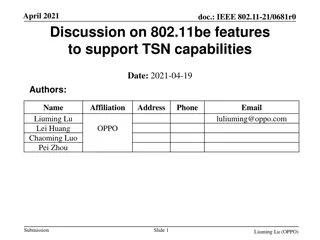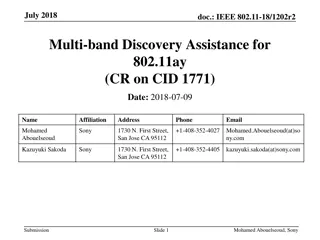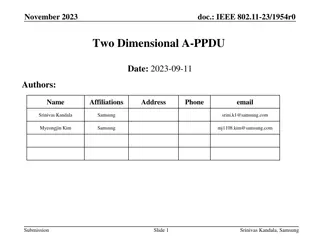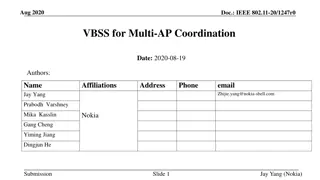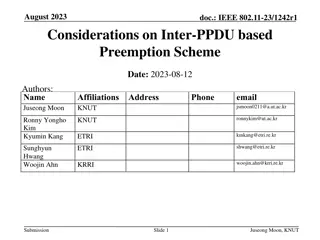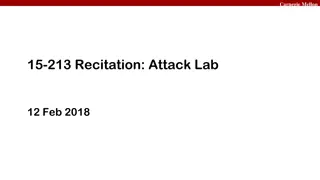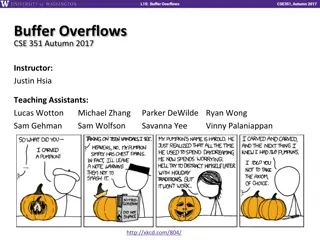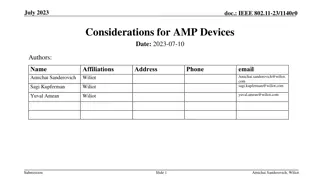Improving Low-Latency Buffer Status Reporting in IEEE 802.11
Proposal for enhancing the Buffer Status Report (BSR) mechanism in IEEE 802.11 to include timing constraints for transmitting latency-sensitive traffic. Suggestions involve adding TSPEC-based signaling and efficient mechanisms for Enhanced Traffic APs to ascertain low-latency traffic status. The current BSR lacks real-time information for aperiodic latency-sensitive transmissions, hindering efficient resource allocation.
Download Presentation

Please find below an Image/Link to download the presentation.
The content on the website is provided AS IS for your information and personal use only. It may not be sold, licensed, or shared on other websites without obtaining consent from the author. Download presentation by click this link. If you encounter any issues during the download, it is possible that the publisher has removed the file from their server.
E N D
Presentation Transcript
September 2021 doc.: IEEE 802.11-21/1577r2 CR for Low-Latency BSR Date: 2021-09-06 Authors: Name Stephane Baron Affiliations Canon Address Rue de la touche Lambert, Rennes Phone email stephane.baron@crf.canon.fr Pascal Viger Canon pascal.viger@crf.canon.fr Romain Guignard Canon Romain.guignard@crf.canon.fr Mika l Lorgeoux Canon Mickael.Lorgeoux@crf.canon.fr Submission Slide 1 Pascal Viger, Canon
September 2021 doc.: IEEE 802.11-21/1577r2 Abstract In this contribution, we propose alternative solutions to add a timing constraint information in BSR for transmitting latency-sensitive traffics. Submission Slide 2 Pascal Viger, Canon
September 2021 doc.: IEEE 802.11-21/1577r2 CIDs related to BSR for low-latency Clause Number 9.2.4.6a.4 CID Commenter Comment Proposed Change 6525 Pascal VIGER There is plan to add TSPEC based signaling to provide parameters that describe traffic characteristics within the SCS procedure, especially the low latency (LL) parameters, so that AP shall be able to create an optimal schedule . Unfortunatly, it is well known that TSPEC is never well specified and does not inform the real amount of LL at a given time inside buffer's STA. An updated BSR shall be provided for Latency Sensitive data An updated BSR Control shall inform the AP scheduler of an amount of data with regards to a timing indication, which provides the expected date for delivery (e.g. UL trigger). This greatly helps the AP scheduling UL RUs accordingly (date and size). Volunteers: Pascal Viger, Evgeny Khorov, Yiqing Li Assigned: Duncan Ho 4586 Bo Yang 9.3.1.22 35.7.4 When AP triggers uplink transmission of low latency traffics during rTWT SPs, there is no way for AP to know whether low latency TIDs of a STA is empty or not. It would be inefficient to ask every STA at every rTWT SP considering that low latency traffics are not fully predictable Define a more efficient mechanism for EHT APs, so a EHT AP would know which STAs have low latency traffics to be scheduled during rTWT SPs Volunteers: Pascal Viger, Boyce Bo Yang, Xiaofei Wang, Rubayet Shafin, Duncan Ho, Jinyoung Chun, Xiandong Dong, Jonghun Han 4587 Bo Yang 9.3.1.22 35.7.4 EHT AP lacks of a efficient mechanism to solicit buffer status of low latency TIDs from non-AP STAs. Non-AP STAs may send a ambigous overall buffer status of all ACs in response to a BSRP Trigger frame now. Add a indication in current BSRP Trigger frames to indicate that a BSRP Trigger is to ask buffer status of low latency TIDs Assigned: Chunyu Hu Volunteers: Pascal Viger, Evgeny Khorov, Yiqing Li 5022 Evgeny Khorov Add the ability to indicate delay constraints for RTA traffic in BSR 9.2.4.6.3a As in comment Assigned: Chunyu Hu Volunteers: Pascal Viger, Evgeny Khorov, Yiqing Li, Jay Yang, Junghoon Suh 5023 Evgeny Khorov Add the ability to indicate the requested channel time in the BSR for TXOP sharing 9.2.4.6.3a As in comment Assigned: JINYOUNG CHUN Submission Slide 3 Pascal Viger, Canon
September 2021 doc.: IEEE 802.11-21/1577r2 Discussion Buffer status report (BSR) is used to indicate to the AP the amount of data the STA has available in its queues for transmission. 802.11ax D8.0 26.5.5 Buffer status report operation : A non-AP STA delivers buffer status reports (BSRs) to assist its AP in allocating UL MU resources. Today, this is non efficient for latency-sensitive/realtime traffic: Current BSR does not have indication of the timing requirements TSPEC-like technics are mainly based on mean rate assumptions, this is not live information and as such not adapted to aperiodic latency sensitive traffic. latency is especially not guaranteed for fluctuant traffic. Therefore it is necessary to allow the station to indicate the timing/delay constraint related to the pending traffic This information is mandatory for a STA to inform its AP about its real and instant needs for sending low latency and fluctuating traffic. Submission Slide 4 Pascal Viger, Canon
September 2021 doc.: IEEE 802.11-21/1577r2 Principle : Low-latency Buffer Status report (LL-BSR) Add a timing indication in order for the AP to schedule UL MU : Traffic Id Amount of data Delay Bound new Present in existing BSR formats The delay bound is a current live information for the AP, which provides simplicity and efficiency for scheduling next communication slots. Note: while LL-BSR is independent mechanism, it may act as complement to TSPEC for fluctuant (e.g. VBR) traffic, by quantifying a buffered data with regards to an SP or Delay Bound interval LL-BSR includes an amount of data, linked with a boundary timing, which results in an indication of an amount of data to be delivered under a given delay. STA delivers LL-BSRs to assist its AP in allocating MU resources for low latency data Submission Slide 5 Pascal Viger, Canon
September 2021 doc.: IEEE 802.11-21/1577r2 Examples of various possible formats Option 1: New variant of A-Control subfield for 11be ID Queue Size BSR Duration Unit Nominal BSR Bound Duration (TID/TSID/SCSID) The ID subfield identifies the Traffic to which the corresponding buffer status belongs. We can take the opportunity to enhance granularity : Values for illustration only: 0-7 : TID; 8-15: TSID; > 16: SCSID or TWT Flow ID The BSR Duration Unit subfield indicates the unit of the Nominal BSR Bound Duration subfield. e.g. is set to 0 if the unit is 256 s, is set to 1 if the unit is a Time Unit (TU), set to 2 if the unit is expressed in multiple of TBTTs The Nominal BSR Bound Duration subfield indicates the maximum amount of time, in the units indicated by the BSR Duration Unit subfield, that the STA is expected to elapse from the transmission of the frame including the BSR until the next triggering frame, in order to complete transmission of buffered data specified in Queue Size subfield for the identified Traffic. Submission Slide 6 Pascal Viger, Canon
September 2021 doc.: IEEE 802.11-21/1577r2 Option 2: Format based on modified 11ax BSR Control (ACI = AC Index) ACI Bitmap Scaling Factor Queue Size High Delta TID ACI High Delay bound Used to indicate the LL-BSR format . e.g. ACI Bitmap = 0; Delta TID = 0 Replaces Queue Size All LL-BSR = high priority AC + one queue size + one Delay Bound The ACI High subfield indicates the ACI of the AC for which the LL-BSR is indicated in the Queue Size High subfield The Queue Size High subfield indicates the amount of buffered traffic The Delay Bound subfield indicates the Delay Bound in TUs, rounded down to the nearest TU, for the amount of buffered traffic to be transmitted as specified by Queue Size High subfield Backward compatible : Queue Size All subfield is replaced by a Delay Bound subfield specific number of bits in the ACI Bitmap subfield set to 0 may indicate the LL-BSR Submission Slide 7 Pascal Viger, Canon
September 2021 doc.: IEEE 802.11-21/1577r2 Option 3: format as a complement to legacy QoS_Control BSR STA reports the queue size for a given TID in the Queue Size subfield of the QoS Control field in QoS Data/Null frames it transmits STA sets the B4 (LL-BSR indication bit) to 0 to indicate that the BSR is an LL- BSR, while the Delay Bound information is present in a Delay Bound subfield of a LL-BSR Control subfield. Backward compatible Issue to consider: REVme D0.4 (section 10.8) mandates that MPDUs aggregated in the same AMPDU shall contain the same HT Control field Octets: 2 2 6 0 or 6 0 or 6 0 or 6 0 or 2 0 or 2 0 or 4 Variable 4 Frame control Duration /ID Address 1 Address 2 Address 3 Sequence Control Address 4 QoS Control HT/EHT Control Frame body FCS A-Control Control 1 Control N Padding LL-BSR B0 B3 bit B4 set to 0 for LL- BSR indication Control ID = TBD set to a new value for LL- BSR Control Delay Bound Size Bits: 4 Submission Slide 8 Pascal Viger, Canon
September 2021 doc.: IEEE 802.11-21/1577r2 Summary This contribution proposes a BSR adapted to latency sensitive streams (called LL-BSR). A timing/delay indication is included in order to specify an amount of data to be delivered under a given delay. The AP uses the timing information associated with the LL-BSR to adapt its scheduling. Preferred option is option 1 : New variant of A-Control subfield, dedicated to low latency for 11be because it can support various traffic identifications : TID, TSID, SCSID and not only AC (Motivation explained in [2], CR for Low-Latency stream identification ) Submission Slide 9 Pascal Viger, Canon
September 2021 doc.: IEEE 802.11-21/1577r2 Straw Poll #1 Do you support that 802.11be provides a new BSR for latency- sensitive traffics (LL-BSR) ? A timing indication is provided (in addition to Traffic identification and amount of data), to specify the maximum amount of time that the STA is expected to elapse from the transmission of the frame including this LL-BSR until the next triggering frame, in order to complete transmission of specified buffered data. Results: Y/N/A Submission Slide 10 Pascal Viger, Canon
September 2021 doc.: IEEE 802.11-21/1577r2 Straw Poll #2 Which option do you support for Low-latency BSR format ? Option 1 (completely new variant of A-Control subfield, which can identify TID/TSID/SCSID ) Option 2 (based on a modified 11ax A-Control BSR) Option 3 (11e legacy BSR, complemented with a Delay Bound A-Control) Do not know / No matters which one Results: Submission Slide 11 Pascal Viger, Canon
September 2021 doc.: IEEE 802.11-21/1577r2 Reference [1]. Draft P802.11be_D1.1 [2]. 11-20-1686r0 : CR for Low-Latency stream identification Submission Slide 12 Pascal Viger, Canon



